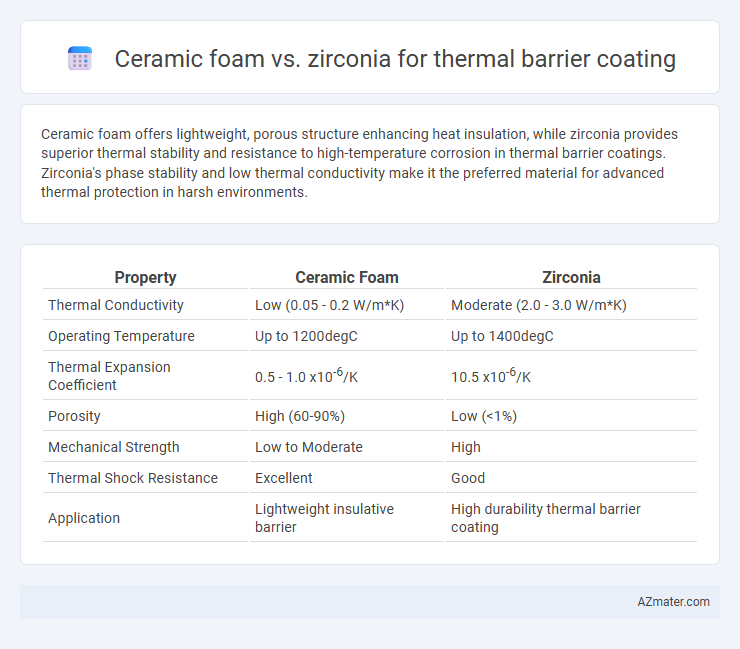Ceramic foam offers lightweight, porous structure enhancing heat insulation, while zirconia provides superior thermal stability and resistance to high-temperature corrosion in thermal barrier coatings. Zirconia's phase stability and low thermal conductivity make it the preferred material for advanced thermal protection in harsh environments.
Table of Comparison
| Property | Ceramic Foam | Zirconia |
|---|---|---|
| Thermal Conductivity | Low (0.05 - 0.2 W/m*K) | Moderate (2.0 - 3.0 W/m*K) |
| Operating Temperature | Up to 1200degC | Up to 1400degC |
| Thermal Expansion Coefficient | 0.5 - 1.0 x10-6/K | 10.5 x10-6/K |
| Porosity | High (60-90%) | Low (<1%) |
| Mechanical Strength | Low to Moderate | High |
| Thermal Shock Resistance | Excellent | Good |
| Application | Lightweight insulative barrier | High durability thermal barrier coating |
Introduction to Thermal Barrier Coatings
Thermal barrier coatings (TBCs) are advanced materials applied to improve the thermal resistance of components in high-temperature environments, such as gas turbines and aerospace engines. Ceramic foam and zirconia-based coatings are prominent options; ceramic foam offers lightweight and porous structures enhancing thermal insulation, while yttria-stabilized zirconia (YSZ) remains the industry standard due to its low thermal conductivity and high phase stability. The choice between ceramic foam and zirconia depends on application-specific thermal conductivity requirements, mechanical durability, and operating temperature thresholds.
Overview of Ceramic Foam Coatings
Ceramic foam coatings offer a highly porous structure that enhances thermal insulation and reduces thermal conductivity in thermal barrier applications. These coatings provide superior strain tolerance and thermal shock resistance compared to dense zirconia coatings, making them ideal for extreme temperature environments. The interconnected pore network in ceramic foam coatings improves heat dissipation and extends the lifespan of underlying substrates in gas turbines and aerospace engines.
Zirconia as a Thermal Barrier Material
Zirconia, especially stabilized zirconia, is widely recognized as a superior thermal barrier coating material due to its low thermal conductivity and high thermal stability at temperatures exceeding 1200degC. Compared to ceramic foam, zirconia coatings provide enhanced resistance to thermal shock, oxidation, and corrosion while maintaining excellent mechanical integrity under cyclic thermal loading conditions. Its ability to form a dense, adherent layer makes zirconia ideal for protecting turbine blades and engine components in aerospace and automotive applications.
Key Physical Properties Comparison
Ceramic foam exhibits higher porosity and lower density compared to Zirconia, resulting in superior thermal insulation but reduced mechanical strength. Zirconia, specifically stabilized zirconia, offers exceptional thermal stability, lower thermal conductivity, and greater fracture toughness essential for high-temperature thermal barrier coatings (TBCs). The choice between ceramic foam and zirconia depends on the balance required between thermal insulation efficiency and mechanical durability in TBC applications.
Thermal Insulation Effectiveness
Ceramic foam exhibits superior thermal insulation effectiveness due to its highly porous structure, which significantly reduces heat conduction and enhances thermal barrier performance. Zirconia, especially yttria-stabilized zirconia (YSZ), is widely used for its excellent phase stability and toughness but offers lower thermal insulation compared to ceramic foam because of its denser microstructure. The choice between ceramic foam and zirconia depends on balancing insulation needs with mechanical durability and operational temperature constraints.
Durability and Longevity
Zirconia-based thermal barrier coatings exhibit superior durability and longevity compared to ceramic foam due to zirconia's enhanced phase stability and resistance to thermal cycling and mechanical stress. The tetragonal phase of yttria-stabilized zirconia prevents crack propagation, significantly extending the coating lifespan under high-temperature conditions. Ceramic foam, while lightweight and porous, tends to have lower mechanical strength and faster degradation rates, limiting its effectiveness in long-term thermal insulation applications.
Application Methods and Compatibility
Ceramic foam thermal barrier coatings are typically applied using slurry spraying or dip coating, providing high porosity and thermal insulation for applications like gas turbines and heat exchangers. Zirconia coatings, particularly yttria-stabilized zirconia (YSZ), are predominantly deposited through plasma spray and electron beam physical vapor deposition (EB-PVD), offering superior phase stability and resistance to thermal cycling in aero engines and industrial turbines. Compatibility varies as ceramic foam suits lower-stress environments requiring high thermal insulation, while zirconia excels in high-temperature, mechanically demanding conditions due to its toughness and chemical stability.
Cost Analysis and Economic Viability
Ceramic foam offers lower material and manufacturing costs compared to zirconia, making it a more economically viable option for thermal barrier coatings in cost-sensitive applications. Zirconia, known for its superior thermal stability and durability, commands higher prices due to complex processing and raw material expenses. The cost-benefit balance favors ceramic foam when budget constraints prioritize affordability over the exceptional performance characteristics of zirconia.
Performance in Extreme Environments
Ceramic foam thermal barrier coatings provide excellent thermal insulation and low density, enhancing heat resistance in high-temperature environments but may lack the mechanical strength of zirconia-based coatings. Zirconia, especially yttria-stabilized zirconia (YSZ), exhibits superior thermal stability, phase stability, and resistance to thermal shock, making it the preferred material for turbine engines and aerospace applications under extreme thermal cycles. Performance in extreme environments favors zirconia for its durability and oxidation resistance, while ceramic foam coatings offer benefits in applications prioritizing lightweight thermal insulation.
Choosing the Right Material: Ceramic Foam vs Zirconia
Ceramic foam and zirconia serve distinct roles in thermal barrier coatings, with ceramic foam offering superior thermal insulation due to its porous structure and low thermal conductivity. Zirconia, especially yttria-stabilized zirconia (YSZ), is renowned for its high thermal stability, phase stability, and resistance to thermal cycling, making it ideal for high-temperature environments. Selecting between ceramic foam and zirconia depends on application-specific requirements such as operating temperature, thermal gradient, mechanical stress, and coating thickness.

Infographic: Ceramic foam vs Zirconia for Thermal barrier coating
 azmater.com
azmater.com